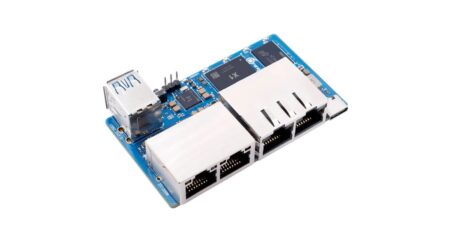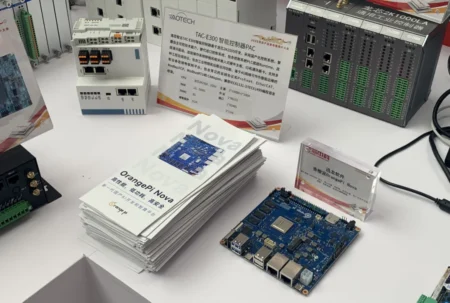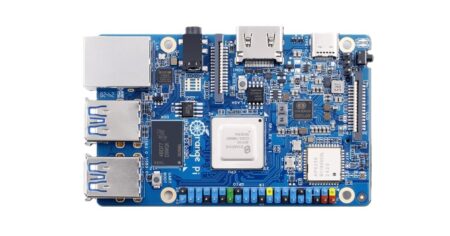Raspberry Pi 4 vs NanoPi M4V2: Which One is More Powerful?
In this general hardware benchmark comparison, we will focus on comparing the performance of the Raspberry Pi 4 vs NanoPi M4V2 SBC. So first thing first, let’s compare both boards specifications and get a more clear view of the features including interfaces each board has to offer in terms of value/price ratio.
Both SBCs are based on the ARM Cortex-A72 microarchitecture implementing the ARMv8-A 64-bit instruction set. The NanoPi M4V2 SBC is based on Rockchip Solution powered by a hex (6) Cores CPU priced at $70. Against it, Its main competitor. The Raspberry Pi 4 SBC powered by a Quad-core Broadcom processor, priced at a retail price between $60-80.
Raspberry Pi 4 Specs
| Architecture | ARM Cortex-A72 |
| SoC | Broadcom BCM2711 |
| Processor Cores | Quad-core Cortex-A72 (ARM v8) 64-bit SoC @ 1.5GHz |
| Processor Speed | 1.5GHz per core |
| RAM | 1GB, 2GB, 4GB LPDDR4-3200 SDRAM |
| Video/Audio output | 2 × micro-HDMI ports (up to 4kp60 supported)
Dual-monitor support |
| Video-Input | 2-lane MIPI DSI display port
2-lane MIPI CSI camera port |
| Audio Headphone jack | Yes, Output Only |
| Storage Interfaces | 2 USB 3.0 ports; 2 USB 2.0 ports, Micro-SD Slot |
| Header Pin Extension | 24Pin – 2 independent native USB 2.0 Host + PCIe x2
Standard 40 pin GPIO header |
| Onboard eMMC | No |
| Wireless LAN | 2.4Ghz and 5Ghz Dual-Band On-Board Antenna, supporting IEEE 802.11 b/g/n/ac |
| Gigabit Ethernet | Yes |
| Max Power Draw | 3A |
| Ethernet / Local Area Network | 1000mbps Gigabit (802.3ab using dedicated chip) |
| Bluetooth | Bluetooth 5.0 |
| Video Chip | Broadcom VideoCore VI @ 500MHz |
| 2 Pin RTC battery input connector | No |
| Power management chip | Yes, MaxLinear PMIC |
NanoPi M4V2 Specs
| Architecture | ARM big.LITTLE |
| SoC | RockChip RK3399 |
| Processor Cores | Dual-Core Cortex-A72(up to 2.0GHz) + Quad-Core Cortex-A53 (up to 1.5GHz) |
| Processor Speed | 1.5GHz – 1.8GHz per core |
| RAM | 4GB Dual-Channel 4GB LPDDR4 |
| Video/Audio output | HDMI 2.0a supports 4K@60Hz,HDCP 1.4/2.2 one 4-Lane MIPI-DSI |
| Video-Input | one or two 4-Lane MIPI-CSI, dual ISP, up to 13MPix/s,supports simultaneous input of dual-camera data |
| Audio Headphone jack | Yes, Input & Output |
| Storage Interfaces | 4 USB 3.0 ports, Micro-SD Slot |
| Header Pin Extension | Standard 40 pin GPIO header |
| Onboard eMMC | Yes, via Module |
| Wireless LAN | 2.4Ghz and 5Ghz Dual-Band On-Board Antenna, supporting IEEE 802.11 b/g/n/ac |
| Gigabit Ethernet | Yes |
| Max Power Draw | 3A |
| Ethernet / Local Area Network | 1000mbps Gigabit (802.3ab using dedicated chip) |
| Bluetooth | Bluetooth 4.1 |
| Video Chip | ARM Mali-T860 MP2 @ 700MHz |
| 2 Pin RTC battery input connector | RTC Battery: 2 Pin 1.27/1.25mm RTC battery input connector |
| Power management chip | Yes, RK808-D PMIC |
Stress Test with the Sysbench tool
Raspberry Pi 4
Operating system: Raspbian Buster
sysbench –num-threads=4 –test=cpu –cpu-max-prime=20000 –validate run
total time: 62.6426s
Results were taken from the following sources:
- Raspberrypi.org Official Forum: https://bit.ly/2YFU3fE
Maximum prime number checked in CPU test: 20000
Test execution summary:
total time: 62.8169s
total number of events: 10000
total time taken by event execution: 251.2240
per-request statistics:
min: 24.94ms
avg: 25.12ms
max: 68.14ms
approx. 95 percentile: 25.10ms
Threads fairness:
events (avg/stddev): 2500.0000/4.24
execution time (avg/stddev): 62.8060/0.01
NanoPi M4V2
Operating system: Armbian
sysbench –num-threads=4 –test=cpu –cpu-max-prime=20000 –validate run
Maximum prime number checked in CPU test: 20000
Test execution summary:
total time: 10.0022s
total number of events: 19546
total time taken by event execution: 251.2240
per-request statistics:
min: 1.42ms
avg: 2.05ms
max: 17.37ms
approx. 95 percentile: 3.55ms
sum: 39985.88
Threads fairness:
events (avg/stddev): 4886.5000/2101.50
execution time (avg/stddev): 9.9965/0.00
Translating the data to more clear to understand results:
| SBC | Latency (ms) Min | Latency (ms) Max | Total execution Time |
| Raspberry Pi 4 | 24.95 | 68.14 | 62.6426s |
| NanoPi M4V2 | 1.42 | 17.37 | 10.0022s |
| The Winner | NanoPi M4V2 | ||
Note: Lower execution time it better!
Final words
Based on my personal opinion and above preliminary results, the NanoPi M4V2 outperforms the new raspberry pi 4 by approximately %84. Although raspberry pi 4 offers much better software support and a wide selection of Linux distributions, including better documentation and a more robust community for bug-testing. My advice, if you are looking for a more powerful SBC go with the NanoPi M4V2. If you don’t need much computing power than raspberry pi 4 is the best choice between the two.




